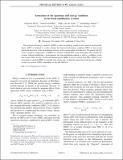| dc.contributor.author | Ecker, Christian | |
| dc.contributor.author | Grumiller, Daniel | |
| dc.contributor.author | van der Schee, Wilke | |
| dc.contributor.author | Stanzer, Philipp | |
| dc.date.accessioned | 2018-06-26T14:14:34Z | |
| dc.date.available | 2018-06-26T14:14:34Z | |
| dc.date.issued | 2018-06 | |
| dc.date.submitted | 2017-11 | |
| dc.identifier.issn | 2470-0010 | |
| dc.identifier.issn | 2470-0029 | |
| dc.identifier.uri | http://hdl.handle.net/1721.1/116607 | |
| dc.description.abstract | The quantum null energy condition (QNEC) is a new local energy condition that a general quantum field theory (QFT) is believed to satisfy, relating the classical null energy condition (NEC) to the second functional derivative of the entanglement entropy in the corresponding null direction. We present the first series of explicit computations of QNEC in a strongly coupled QFT, using holography. We consider the vacuum, thermal equilibrium, a homogeneous far-from-equilibrium quench as well as a colliding system that violates NEC. For the vacuum and thermal phase, QNEC is always weaker than NEC. While for the homogeneous quench QNEC is satisfied with a finite gap, we find the interesting result that the colliding system can saturate QNEC, depending on the null direction. | en_US |
| dc.description.sponsorship | United States. Department of Energy (Contract DE-SC0011090) | en_US |
| dc.publisher | American Physical Society | en_US |
| dc.relation.isversionof | http://dx.doi.org/10.1103/PhysRevD.97.126016 | en_US |
| dc.rights | Creative Commons Attribution | en_US |
| dc.rights.uri | http://creativecommons.org/licenses/by/3.0 | en_US |
| dc.source | American Physical Society | en_US |
| dc.title | Saturation of the quantum null energy condition in far-from-equilibrium systems | en_US |
| dc.type | Article | en_US |
| dc.identifier.citation | Ecker, Christian et al. "Saturation of the quantum null energy condition in far-from-equilibrium systems." Physical Review D 97, 12 (June 2018): 126016 | en_US |
| dc.contributor.department | Massachusetts Institute of Technology. Center for Theoretical Physics | en_US |
| dc.contributor.department | Massachusetts Institute of Technology. Laboratory for Nuclear Science | en_US |
| dc.contributor.mitauthor | van der Schee, Wilke | |
| dc.relation.journal | Physical Review D | en_US |
| dc.eprint.version | Final published version | en_US |
| dc.type.uri | http://purl.org/eprint/type/JournalArticle | en_US |
| eprint.status | http://purl.org/eprint/status/PeerReviewed | en_US |
| dc.date.updated | 2018-06-25T18:00:11Z | |
| dc.language.rfc3066 | en | |
| dspace.orderedauthors | Ecker, Christian; Grumiller, Daniel; van der Schee, Wilke; Stanzer, Philipp | en_US |
| dspace.embargo.terms | N | en_US |
| dc.identifier.orcid | https://orcid.org/0000-0003-2477-6623 | |
| mit.license | PUBLISHER_CC | en_US |
